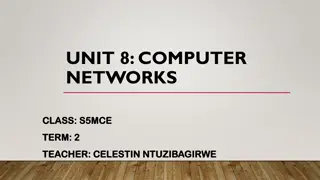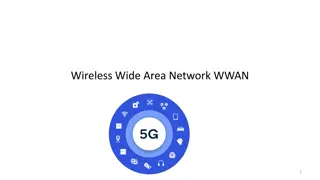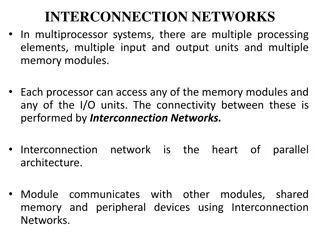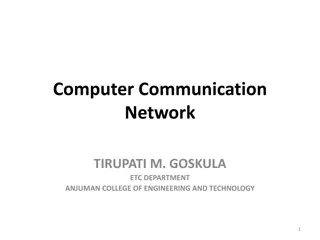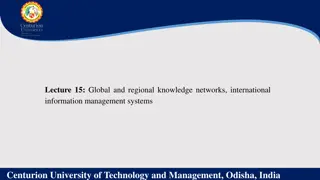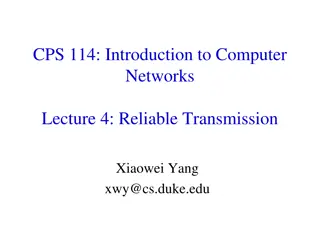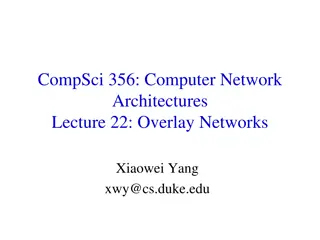Enhancing 5G Networks with Reliable IP Underlay
Addressing the need for reliability in 5G networks, this article explores using IP as an underlay network to support new services and applications demanding improved networking behaviors. It discusses the connectivity provided by the underlay network, the evolution of IP, and the challenges in building reliability over the Internet, emphasizing the importance of IP in enabling reliable communication for emerging technologies.
Download Presentation

Please find below an Image/Link to download the presentation.
The content on the website is provided AS IS for your information and personal use only. It may not be sold, licensed, or shared on other websites without obtaining consent from the author.If you encounter any issues during the download, it is possible that the publisher has removed the file from their server.
You are allowed to download the files provided on this website for personal or commercial use, subject to the condition that they are used lawfully. All files are the property of their respective owners.
The content on the website is provided AS IS for your information and personal use only. It may not be sold, licensed, or shared on other websites without obtaining consent from the author.
E N D
Presentation Transcript
Using IP to Underpin 5G Networks Making the Unreliable Reliable Adrian Farrel adrian@olddog.co.uk 28th IEEE International Conference on Network Protocols October 13th, 2020 OLD DOG CONSULTING
Topics What Services do we Want to Enable? What do the Services Demand? What is an Underlay Network? Why use IP? But IP is Best-Effort isn t it? How To Build Reliability over the Internet? Proposals to make IP Predictable Architectural and Deployment Considerations Evolution or Revolution?
5G and the New Services Lots of pizzazz and hype! But, this is not really about 5G, it s about new services on the Internet 5G just makes them more broadly available New services will come along Beware of using them as justification for technology Look for the real services and applications What applications? Remote surgery Haptic interactions Holographic conferencing Multi-player VR or AR gaming Vehicle automation Manufacturing Crowd-sourced video Digital trading
New Services Need New Network Behaviours Most of the new applications demand some improvement in networking Greater bandwidth (throughput) Lower delay (less latency) Less variation in delivery time (reduced jitter) More independence (less impacted by other traffic) Better reliability (less packet loss / corruption) Better resiliency (less affected by network failures) This is not a new list!
The Underlay Provides Connectivity Every connection has an underlay providing connectivity Even the fibre is carried in a duct But underlay is subjective We care about connectivity provided for our application The applications we are talking about run over the Internet That makes IP the prime candidate 5G applications and network segments can be connected Probably over the Internet Again, IP is the candidate underlay network
So Who is Perfect? IP was designed with specific design goals It is a simple encapsulation for end-to-end delivery The IP network also had simple-to-state goals Connectionless network (no state in the network) Recovery from network faults Best-effort delivery Everything else happens in other layers Lower layers may be made reliable and may include traffic engineering Higher layers may include retransmission, security, prioritisation Thus, IP is not: Predictable Dependable High-quality
How To Deliver Reliability Over the Internet Many technologies exist to underpin the Internet Ethernet, MPLS, OTN These do not provide end-to-end quality of service Solutions in hand look at how to provide predictability over IP Real-time Transport Protocol (RTP) As old as the hills (1986) and widely used (e.g. VoIP and WebRTC) Helps handle jitter, packet loss, out-of-order delivery Multi-Path TCP (MPTCP) Experimental (2013) moved to standards track (2020) Inverse multiplexing to maximise use of bandwidth and improve throughput QUIC Google proprietary (2012) brought to the IETF Already widely deployed Multiplexed connections and somewhat reduced latency In the dustbin of history? Differentiated Services (DiffServ) Somewhat used, but not substantially Colour packets for different services Allows prioritised queuing and different treatments at transit routers Integrated Services (IntServ) Fine-grain description of traffic flows Prioritisation of traffic and reservation of network resources in conjunction with a protocol such as RSVP Too complex and requires end-to-end support in the network
Making IP Predictable Increased pressure to make IP behave in known ways Guarantee the quality of service Tends to drive some form of connection-oriented approach RSVP placed state in the routers (not talking about MPLS) Segment Routing places state in the packets and the management station Today s discussions are about: Placing flow quality identifiers in the packets Programming the network to handle packets differently Different queuing and prioritisation Assumes many things: Sufficient network resources are available Traffic never swamps the network Central management can predict how to distribute traffic Routers are aware of marking schemes to not congest traffic
Deployment Considerations What have we learned about deploying new stuff in the Internet? Sub-IP Can be done hop-by-hop but requires adjacent nodes to interoperate Usually done in islands and can be slow to achieve Incentive is operational or commercial IP Needs all routers in an administrative domain to be updated Better if full end-to-end path is upgraded Remarkably hard to show incentive (just look at IPv6) May be practical in specialist networks End-to-end (application level, or transport) Just update the end points Old versions continue to be supported (with lower functionality) Easy to achieve Incentive is either additional features or bundled in regular release packs
Ye cannae change the laws of physics But seriously, you can t Yes, we re squeezing a little more out of hollow fibres No, the speed of light is a limiting factor Thus, round-trip latency is governed by distance People talk about <1ms round trip times for some applications That s 93 miles each way Assuming no processing, routing, buffering That has many implications for how we architect our networks
Network Architecture is Evolving Processing is moving to the edge Bandwidth is increasing Private connectivity networks link remote data centres The Internet is, once again, a network of networks Major Datacentre Micro Datacentre Private Network Access Internet Hosts This doesn t help you if you want low latency across the world Battlefield surgery conducted from the home nation Multi-player inter-continental games High-speed market trading Sensitive haptic interactions
Evolution or Revolution? Haven t we been here before? Repeating cycle of concern Internet will not scale We need to do something Bandwidth reservation IntServ, etc. But each time we have addressed concerns with increased capacity at a lower cost Why do we think it is different this time? Do we try to fix IP or do we build a replacement? Evolution or revolution? Maybe neither, given what we know about deployment and architecture But what could we do instead? Improve the underlay and the overlay We clearly need to spend time on research Image after Loughlain McPherson
Research What applications and services do we really need to support? There is a difference between dreams and immediacy What can we achieve by enhancing tunnelling and transport protocols? What have we learnt from RTP, QUIC, and MPTPC? What could we do through better operations and management? How should we design our applications to handle network effects? Don t we already do this? What form does research take? Experimental protocols and implementations Quantitative measurements of network behaviour Where can we do our research? Universities and corporate research labs Publish in journals and at the IRTF
Questions and Follow-up OLD DOG CONSULTING adrian@olddog.co.uk




